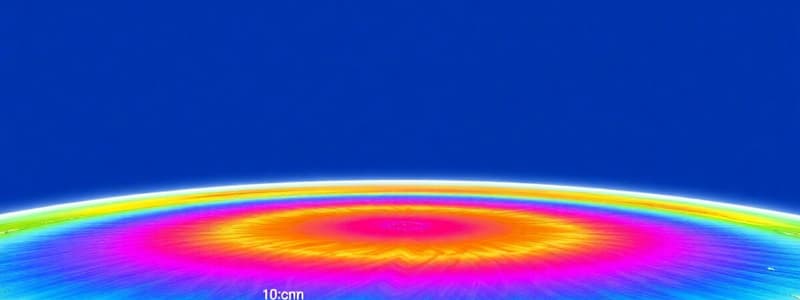Podcast
Questions and Answers
What are the primary forces that contribute to the formation of the Ekman spiral?
What are the primary forces that contribute to the formation of the Ekman spiral?
- Coriolis force, centripetal force, and atmospheric pressure
- Pressure gradient force, Coriolis force, and turbulent drag (correct)
- Gravitational force, thermal force, and frictional force
- Pressure gradient force and gravitational force
What is the primary purpose of the surface layer within the boundary layer?
What is the primary purpose of the surface layer within the boundary layer?
- To influence upper atmosphere weather patterns
- To create vertical atmospheric pressure systems
- To block heat and moisture from reaching the surface
- To facilitate the exchange of momentum, heat, and moisture with the surface (correct)
How does the modified Ekman layer improve upon the traditional Ekman layer model?
How does the modified Ekman layer improve upon the traditional Ekman layer model?
- By eliminating the influence of turbulence
- By simplifying the wind profile to ignore surface effects
- By focusing solely on the Coriolis effect
- By combining the logarithmic surface layer profile with the Ekman spiral (correct)
What mechanism is primarily responsible for vertical transport of heat, moisture, and momentum within the boundary layer?
What mechanism is primarily responsible for vertical transport of heat, moisture, and momentum within the boundary layer?
Which process describes the transfer of air from the mixed layer to the free atmosphere?
Which process describes the transfer of air from the mixed layer to the free atmosphere?
What is a characteristic of moist air compared to dry air at the same temperature?
What is a characteristic of moist air compared to dry air at the same temperature?
Which layer of the Planetary Boundary Layer (PBL) is closest to the ground?
Which layer of the Planetary Boundary Layer (PBL) is closest to the ground?
What phenomenon is primarily responsible for vertical transport within the PBL?
What phenomenon is primarily responsible for vertical transport within the PBL?
Which of the following describes the condition of the Mixed Layer within the PBL?
Which of the following describes the condition of the Mixed Layer within the PBL?
What factor influences the height of the Surface Layer in the PBL?
What factor influences the height of the Surface Layer in the PBL?
What happens to wind speed in the Surface Layer?
What happens to wind speed in the Surface Layer?
What is the primary role of the PBL?
What is the primary role of the PBL?
What contributes to the superadiabatic lapse rate observed during daytime in the Surface Layer?
What contributes to the superadiabatic lapse rate observed during daytime in the Surface Layer?
What characterizes the Entrainment Zone (EZ)?
What characterizes the Entrainment Zone (EZ)?
What is mean wind primarily responsible for in atmospheric dynamics?
What is mean wind primarily responsible for in atmospheric dynamics?
What is the effect of daytime heating on the virtual potential temperature profile?
What is the effect of daytime heating on the virtual potential temperature profile?
Which scenario describes the state of the atmosphere during nighttime?
Which scenario describes the state of the atmosphere during nighttime?
How does turbulence affect momentum and heat transfer?
How does turbulence affect momentum and heat transfer?
What does Taylor's Hypothesis relate to in atmospheric dynamics?
What does Taylor's Hypothesis relate to in atmospheric dynamics?
What role do waves play in air flow dynamics?
What role do waves play in air flow dynamics?
What is a capping inversion associated with?
What is a capping inversion associated with?
What characterizes convective instability in the atmosphere?
What characterizes convective instability in the atmosphere?
What does the term 'Turbulent Kinetic Energy (TKE)' refer to?
What does the term 'Turbulent Kinetic Energy (TKE)' refer to?
What is the purpose of the Boussinesq approximation in fluid dynamics?
What is the purpose of the Boussinesq approximation in fluid dynamics?
How does the Flux Richardson Number ($R_f$) relate buoyancy and shear?
How does the Flux Richardson Number ($R_f$) relate buoyancy and shear?
What does the 'Energy Cascade' concept describe in turbulence?
What does the 'Energy Cascade' concept describe in turbulence?
In the context of turbulence statistics, what does 'Standard Deviation' measure?
In the context of turbulence statistics, what does 'Standard Deviation' measure?
What is 'Eddy Stress' in atmospheric dynamics?
What is 'Eddy Stress' in atmospheric dynamics?
What does 'Reynolds Averaging' achieve in the study of turbulent flows?
What does 'Reynolds Averaging' achieve in the study of turbulent flows?
Flashcards are hidden until you start studying
Study Notes
Entrainment Zone (EZ)
- The layer at the top of the mixed layer, marked by a stable layer and temperature inversion, where air from the mixed layer is entrained into the free atmosphere.
- Air from the mixed layer is entrained into the free atmosphere due to temperature inversion.
Virtual Potential Temperature Profiles
- Surface heating creates a superadiabatic lapse rate in the surface layer, a nearly isothermal mixed layer, and an entrainment zone at the top during daytime.
- Surface cooling leads to a surface inversion and a stable boundary layer at night, which deepens as the night progresses.
- On sunny days with strong winds, the virtual potential temperature remains nearly constant with height.
- A stable layer atop a convective boundary layer restricts further vertical mixing referred to as a capping inversion.
Planetary Boundary Layer (PBL)
- The PBL is the lowest part of the atmosphere directly influenced by the Earth's surface.
- Surface friction slows down the wind in the PBL, creating turbulence.
- Turbulence mixes air within the PBL, helping transport heat, moisture, and momentum vertically.
- The PBL's height varies by time of day, season, and location, ranging from hundreds of meters to several kilometers.
- Turbulence within the PBL controls vertical transport, whereas molecular processes are negligible outside the PBL due to low viscosity.
Sublayers of the PBL
- The surface layer: Closest to the ground (tens of meters deep), in direct contact with the Earth's surface.
- Features of the surface layer include strong wind shear, a superadiabatic lapse rate during the day, and a logarithmic wind-speed profile.
- The mixed layer: Above the surface layer (hundreds of meters deep), characterized by well-mixed conditions with nearly constant potential temperature and wind speed independent of height.
Turbulent Kinetic Energy (TKE)
- Measures turbulence intensity, defined as half the sum of squared velocity fluctuations.
Flux Richardson Number ($R_f$)
- Indicates the balance between buoyancy production and shear production of turbulence:
- $R_f$ = B/MP, where B is the buoyancy flux and MP is the shear flux.
Eddy Stress
- This is the force exerted by turbulent eddies on the mean flow.
- It is responsible for vertical momentum transport and is given by: $τ = -ρ\overline{u'w'}$, where ρ is the air density.
Theories and Models of the PBL
- Similarity Theory: Assumes a similar PBL structure at different heights.
- K-Theory: Assumes turbulent fluxes proportional to mean variable gradients, applied in neutrally or stably stratified boundary layers.
- Ekman Theory: Describes the wind's balance between pressure gradient force, Coriolis force, and turbulent drag, leading to the Ekman spiral.
Ekman Layer and Spiral
- The Ekman Layer: A theoretical layer where wind is affected by Coriolis force and friction, producing the Ekman spiral.
- Modified Ekman Layer: Combines the logarithmic surface layer profile with the Ekman spiral, offering a more accurate wind profile representation.
Importance of PBL Sub-Layers
- Surface Layer: Facilitates exchange of momentum, heat, and moisture with the surface.
- Upper Layer: Influences large-scale weather patterns.
Communication within Boundary Layers
- Entrainment: Transfer of air from the mixed layer to the free atmosphere at the top of the mixed layer.
- Secondary Circulations: Vertical motions driven by horizontal temperature gradients, transporting heat and moisture globally.
- Turbulent Mixing: Main mechanism for vertical transport of heat, moisture, and momentum.
Key Takeaways
- The PBL's height, structure, and turbulence are essential in atmospheric dynamics.
- Virtual potential temperature and turbulence help define stability and transport within the PBL.
- The Ekman layer and modified Ekman spiral offer theoretical insights into wind profiles.
- Air moves between boundary and upper layers via entrainment, secondary circulations, and turbulent mixing.
Studying That Suits You
Use AI to generate personalized quizzes and flashcards to suit your learning preferences.




